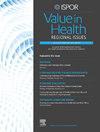Cost-Utility and Budget Impact Analyses of Herpes Zoster Vaccines in Patients With Human Immunodeficiency Virus in Thailand
IF 1.5
Q3 HEALTH CARE SCIENCES & SERVICES
引用次数: 0
Abstract
Objectives
This study aimed to perform cost-utility and budget impact analyses of zoster vaccine live (ZVL) and recombinant zoster vaccine (RZV) compared with no vaccination in patients infected with human immunodeficiency virus (HIV) in Thailand.
Methods
A Markov model was used to estimate costs and outcomes as a quality-adjusted life year from a societal perspective. Costs and outcomes were discounted at 3% per year. Parameters for herpes zoster prevalence and complications were estimated from previous studies. The target population included patients with HIV infection aged ≥18 years with a CD4 count ≥ 200 cells/mm3. Direct medical and nonmedical costs were included in the analysis. Deterministic and probabilistic sensitivity analyses were performed to assess the robustness of the results. A 5-year budget impact analysis of the vaccination program was performed.
Results
The incremental cost-effectiveness ratios of ZVL and RZV compared with no vaccination for patients with HIV infection were $2908.70 and $4391.36 per quality-adjusted life year gain, respectively. ZVL was more likely to be cost-effective. Threshold analysis revealed that RZV could be cost-effective if the cost per dose of RZV was reduced by 0.86%. An additional budget of $15 276 033 for ZVL and $43 338 761 for RZV was estimated to be needed over 5 years.
Conclusions
ZVL is cost-effective at the Thai willingness-to-pay threshold for patients with HIV infection aged ≥18 years with a CD4 count ≥ 200 cells/mm3. RZV needs a 0.86% price reduction to be cost-effective. These findings may be useful in evidence-based policymaking.
泰国带状疱疹疫苗对人类免疫缺陷病毒患者的成本效用和预算影响分析
目的对泰国人免疫缺陷病毒(HIV)感染者接种带状疱疹活疫苗(zv1)和重组带状疱疹疫苗(RZV)与未接种带状疱疹疫苗进行成本-效用和预算影响分析。方法采用马尔科夫模型,从社会角度估计质量调整生命年的成本和结果。成本和结果每年折现3%。带状疱疹患病率和并发症的参数是根据以前的研究估计的。目标人群包括年龄≥18岁且CD4计数≥200细胞/mm3的HIV感染患者。直接医疗和非医疗费用都包括在分析中。进行确定性和概率敏感性分析以评估结果的稳健性。对疫苗接种计划进行了5年预算影响分析。结果与未接种相比,接种zl和RZV的HIV感染者每质量调整生命年增量成本-效果比分别为2908.70美元和4391.36美元。ZVL更可能具有成本效益。阈值分析显示,如果每剂量RZV的成本降低0.86%,则RZV具有成本效益。估计今后5年需要额外预算15 276 033美元用于ZVL, 43 338 761美元用于RZV。结论对于年龄≥18岁且CD4计数≥200细胞/mm3的HIV感染患者,szvl在泰国的支付意愿阈值下具有成本效益。RZV需要降低0.86%的价格才能符合成本效益。这些发现可能对基于证据的政策制定有用。
本文章由计算机程序翻译,如有差异,请以英文原文为准。
求助全文
约1分钟内获得全文
求助全文
来源期刊

Value in health regional issues
Pharmacology, Toxicology and Pharmaceutics-Pharmacology, Toxicology and Pharmaceutics (miscellaneous)
CiteScore
2.60
自引率
5.00%
发文量
127
 求助内容:
求助内容: 应助结果提醒方式:
应助结果提醒方式:


